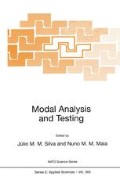Abstract
This chapter provides an examination of viscoelastic damping normally characterized by hysteresis, a complex modulus or frequency dependent damping. Viscoelastic damping exhibited in polymeric and glassy materials as well as in some enamels. Such materials are often added to structures and devices to increase the amount of damping. Examples are rubber mounts and constrained layer damping treatments. Typically in modal analysis the simplest form of modeling damping is used. This form assumes that the damping is a linear, time invariant phenomena chosen to be viscous, or proportional to velocity, motivated by the ability to solve the equations of motion. With this as a first model, one is lead to conclude that viscoelastic behavior causes frequency dependent damping coefficients resulting in the concept of complex modulus. Thus it is not clear how to perform modal analysis of structures with viscoelastic components. Here an alternative formulation is discussed and presented for multiple degree of freedom systems that allows the treatment of hysteretic damping in dynamic finite element formulations, and hence provides a connection to modal analysis and testing.
Access this chapter
Tax calculation will be finalised at checkout
Purchases are for personal use only
Preview
Unable to display preview. Download preview PDF.
References
Christensen, R. M. (1982), Theory of Viscoelasticity: An Introduction, 2nd ed., Academic Press Inc., New York.
Friswell, M. I., and Inman, D. J. (1998), Reduced order models of structures with viscoelastic elements, in review.
Golla, D. F. and Hughes, P. C. (1985), Dynamics of viscoelastic structure-a time domain, finite element formulation, J. of Applied Mechanics, Vol. 52, 897–906.
Guyan, R. J. (1965), Reduction of stiffness and mass matrices, AIAA Journal, Vol. 3, pp.380.
Inman, D. J. (1989), Vibration analysis of viscoelastic beams by separation of variables and modal analysis, Mechanics Research Communications, Vol. 16(4), 213–218.
Lesieutre, G. A., and Mingori, D. L. (1990), Finite element modeling of frequency-dependent material properties using augmented thermodynamic fields, AIAA Journal of Guidance Control and Dynamics, Vol. 13, 1040–1050.
Lesieutre, G. A. (1992), Finite element for dynamic modelling of uniaxial rods with frequency dependent material properties, International Journal of Solids and Structures, Vol. 29, 1567–1579.
Lesieutre, G. A., and Bianchini, E. (1995), Time domain modeling of linear viscoelasticity using anelastie displacement fields, ASME Journal of Vibration and Acoustics, Vol. 117, 424–430.
Lesieutre, G. A., and Govindswamy, K. (1996), Finite element modeling of frequency-dependent and temperature-dependent dynamic behavior of viscoelastic material in simple shear, International Journal of Solids and Structures, Vol. 33, 419–432.
McTavish, D. J. and Hughes, P.C. (1993), Modeling of linear viscoelastic space structures, Journal of Vibration and Acoustics, Vol. 115, 103–113.
Moore, B. C. (1981), Principal component analysis for linear systems: controllability, observability, and model reduction, IEEE Trans. Automat. Contr., Vol. AC-26, 17–32.
Nashif, A. D., Jones, D. and Henderson, J. P. (1985), Vibration Damping, John Willy & Sons, New York.
Rogers, L.C., Johnson, CD., and Keinholz, D. A. (1981), The modal strain energy finite element method and its application to damped laminated beams, The Shock and Vibration Bulletin, Vol. 51.
Ward, I. M. (1983), Mechanical Properties of Solid Polymer, 2nd ed., Wiley & Sons, New York.
Yae, K. H. and Inman, D. J. (1993), Control-oriented order reduction of finite element model, Journal of Dynamic Systems, Measurement, and Control, Vol. 775, 708–711.
Author information
Authors and Affiliations
Editor information
Editors and Affiliations
Rights and permissions
Copyright information
© 1999 Springer Science+Business Media Dordrecht
About this chapter
Cite this chapter
Inman, D.J., Park, C.H. (1999). Damping: An Introduction to Viscoelastic Models. In: Silva, J.M.M., Maia, N.M.M. (eds) Modal Analysis and Testing. NATO Science Series, vol 363. Springer, Dordrecht. https://doi.org/10.1007/978-94-011-4503-9_19
Download citation
DOI: https://doi.org/10.1007/978-94-011-4503-9_19
Publisher Name: Springer, Dordrecht
Print ISBN: 978-0-7923-5894-7
Online ISBN: 978-94-011-4503-9
eBook Packages: Springer Book Archive

